Climate-Informed Management of Irrigated Cotton in Western Kansas to Reduce Groundwater Withdrawals
Abstract
:1. Introduction
2. Materials and Methods
2.1. Cotton Growth Model and Site Characteristics
2.2. ENSO Phase Classification
2.3. Simulations
2.4. Analyses
3. Results and Discussion
3.1. ENSO Phase Effects on Thermal Energy, Precipitation, and Lint Yield
3.2. Crop Response to ENSO Phase and Scenario Irrigation Capacity and Duration Effects
3.3. Split Center-Pivot Irrigation and Water Conservation
4. Summary and Conclusions
Author Contributions
Funding
Data Availability Statement
Conflicts of Interest
Disclaimer
References
- Follett, R.F.; Stewart, C.E.; Pruessner, E.G.; Kimble, J.M. Effects of climate change on soil carbon and nitrogen storage in the US Great Plains. J. Soil Water Conserv. 2012, 67, 331–342. [Google Scholar] [CrossRef]
- Stewart, B.A. Aquifers, Ogallala. In Encyclopedia of Water Science; Stewart, B.A., Howell, T.A., Eds.; Marcel Dekker Inc.: New York, NY, USA, 2003; pp. 43–44. [Google Scholar]
- McGuire, V.L. Water-Level and Recoverable Water in Storage Changes, High Plains Aquifer, Predevelopment to 2015 and 2013–15; U.S. Geological Survey Scientific Investigations Report 2017-5040; U.S. Geological Survey: Reston, VA, USA, 2017; 14p. [CrossRef]
- Whittemore, D.O.; Butler, J.J., Jr.; Wilson, B.B. Status of the High Plains Aquifer in Kansas; Technical Series 22; Kansas Geological Survey: Lawrence, KS, USA, 2018; 14p. [Google Scholar]
- Haacker, E.M.K.; Kendall, A.D.; Hyndman, D.W. Water level declines in the High Plains Aquifer: Predevelopment to resource senescence. Groundwater 2016, 54, 231–242. [Google Scholar] [CrossRef] [PubMed]
- Howell, T.A. Enhancing water use efficiency in irrigated agriculture. Agron. J. 2001, 93, 281–289. [Google Scholar] [CrossRef]
- Colaizzi, P.D.; Gowda, P.H.; Marek, T.H.; Porter, D.O. Irrigation in the Texas High Plains: A brief history and potential reductions in demand. Irrig. Drain. 2009, 58, 257–274. [Google Scholar] [CrossRef]
- Marek, G.W.; Gowda, P.H.; Marek, T.H.; Porter, D.O.; Baumhardt, R.L.; Brauer, D.K. Modeling long-term water use of irrigated cropping rotations in the Texas High Plains using SWAT. Irrig. Sci. 2017, 35, 111–123. [Google Scholar] [CrossRef]
- Gowda, P.H.; Baumhardt, R.L.; Esparza, A.M.; Marek, T.H.; Howell, T.A. Suitability of cotton as an alternative crop in the Ogallala Aquifer Region. Agron. J. 2007, 99, 1397–1403. [Google Scholar] [CrossRef]
- Baumhardt, R.L.; Haag, L.A.; Gowda, P.H.; Schwartz, R.C.; Marek, G.W.; Lamm, F.R. Modeling cotton growth and yield response to irrigation practices for thermally limited growing seasons in Kansas. Trans. ASABE 2021, 64, 1–12. [Google Scholar] [CrossRef]
- Stone, L.R.; Schlegel, A.J.; Gwin, R.E.; Khan, A.H. Response of corn, grain sorghum, and sunflower to irrigation in the High Plains of Kansas. Agric. Water Manag. 1996, 30, 251–259. [Google Scholar] [CrossRef]
- Schlegel, A.J.; Assefa, Y.; O’Brien, D.; Lamm, F.R.; Haag, L.A.; Stone, L.R. Comparison of Corn, Grain Sorghum, Soybean, and Sunflower under Limited Irrigation. Agron. J. 2016, 108, 670–679. [Google Scholar] [CrossRef]
- Mauget, S.A.; Upchurch, D.R. El Niño and La Niña related climate and agricultural impacts over the Great Plains and Midwest. J. Prod. Agric. 1999, 12, 203–215. [Google Scholar] [CrossRef]
- Pu, B.; Fu, R.; Dickinson, R.E.; Fernando, D.N. Why do summer droughts in the Southern Great Plains occur in some La Niña years but not others? J. Geophys. Res. Atmos. 2016, 121, 1120–1137. [Google Scholar] [CrossRef]
- Meinke, H.; Stone, R.C. On tactical crop management using seasonal climate forecasts and simulation modelling—A case study for wheat. Sci. Agric. 1997, 54, 121–129. [Google Scholar] [CrossRef]
- Potgieter, A.B.; Schepen, A.; Brider, J.; Hammer, G.L. Lead time and skill of Australian wheat yield forecasts based on ENSO-analogue or GCM-derived seasonal climate forecasts—A comparative analysis. Agric. For. Meteorol. 2022, 324, 109116. [Google Scholar] [CrossRef]
- Whisler, F.D.; Acock, B.; Baker, D.N.; Fye, R.E.; Hodges, H.F.; Lambert, J.R.; Lemmon, H.E.; McKinion, J.M.; Reddy, V.R. Crop simulation models in agronomic systems. Adv. Agron. 1986, 40, 141–208. [Google Scholar] [CrossRef]
- McKinion, J.M.; Baker, D.N.; Whisler, F.D.; Lambert, J.R. Application of the GOSSYM/COMAX system to cotton crop management. Agric. Syst. 1989, 31, 55–65. [Google Scholar] [CrossRef]
- Harrison, M.T.; Evans, J.R.; Dove, H.; Moore, A.D. Dual-purpose cereals: Can the relative influences of management and environment on crop recovery and grain yield be dissected? Crop Pasture Sci. 2011, 62, 930–946. [Google Scholar] [CrossRef]
- Thorp, K.R.; Ale, S.; Bange, M.P.; Barnes, E.M.; Hoogenboom, G.; Lascano, R.J.; McCarthy, A.C.; Nair, S.; Paz, J.O.; Rajan, N.; et al. Development and Application of Process-based Simulation Models for Cotton Production: A Review of Past, Present, and Future Directions. J. Cotton Sci. 2014, 18, 10–47. [Google Scholar]
- Thorp, K.R.; Hunsaker, D.J.; Bronson, K.F.; Andrade-Sanchez, P.; Barnes, E.M. Cotton irrigation scheduling using the crop growth model and FAO-56 methods: Field and simulation studies. Trans. ASABE 2017, 60, 2023–2039. [Google Scholar] [CrossRef]
- Baumhardt, R.L.; Mauget, S.A.; Gowda, P.H.; Brauer, D.K.; Marek, G.W. Optimizing cotton irrigation strategies as influenced by El Nino Southern Oscillation. Agron. J. 2015, 107, 1895–1904. [Google Scholar] [CrossRef]
- Mauget, S.A.; Zhang, J.; Ko, J. The Value of ENSO Forecast Information to Dual-Purpose Winter Wheat Production in the U.S. Southern High Plains. J. Appl. Meteor. Climatol. 2009, 48, 2100–2117. [Google Scholar] [CrossRef]
- Doorenbos, J.; Kassam, A.H. Yield Response to Water; Irrigation and Drainage Paper 33; FAO: Rome, Italy, 1979; p. 123. [Google Scholar]
- Wanjura, D.F.; Upchurch, D.R. Canopy temperature characteristics of corn and cotton water status. Trans. ASAE 2000, 43, 867–875. [Google Scholar] [CrossRef]
- Bordovsky, J.P.; Mustian, J.T.; Ritchie, G.L.; Lewis, K.L. Cotton irrigation timing with variable seasonal irrigation capacities in the Texas south plains. Appl. Eng. Agric. 2015, 31, 883–897. [Google Scholar] [CrossRef]
- Baumhardt, R.L.; Staggenborg, S.A.; Gowda, P.H.; Colaizzi, P.D.; Howell, T.A. Modeling irrigation management strategies to maximize cotton lint yield and water use efficiency. Agron. J. 2009, 101, 460–468. [Google Scholar] [CrossRef]
- Nair, S.; Maas, S.; Wang, C.; Mauget, S. Optimal field partitioning for center-pivot-irrigated cotton in the Texas High Plains. Agron. J. 2013, 105, 124–133. [Google Scholar] [CrossRef]
- Baker, D.N.; Lambert, J.R.; McKinion, J.M. GOSSYM: A Simulator of Cotton Crop Growth and Yield; South Carolina Agricultural Experiment Station, Technical Bulletin 1089; Clemson University: Clemson, SC, USA, 1983; p. 134. [Google Scholar]
- Staggenborg, S.A.; Lascano, R.J.; Krieg, D.R. Determining cotton water use in a semiarid climate with the GOSSYM cotton simulation model. Agron. J. 1996, 88, 740–745. [Google Scholar] [CrossRef]
- Baumhardt, R.L.; Schwartz, R.C.; Marek, G.W.; Bell, J.M. Planting geometry effects on the growth and yield of dryland cotton. Agric. Sci. 2018, 9, 99–116. [Google Scholar] [CrossRef]
- Allen, M.R.; Dube, O.P.; Solecki, W.; Aragón-Durand, F.; Cramer, W.; Humphreys, S.; Kainuma, M.; Kala, J.; Mahowald, N.; Mulugetta, Y.; et al. Chapter 1: Framing and context. In Global Warming of 1.5 °C. An IPCC Special Report on the Impacts of Global Warming of 1.5 °C above Pre-Industrial Levels and Related Global Greenhouse Gas Emission Pathways, in the Context of Strengthening the Global Response to the Threat of Climate Change, Sustainable Development, and Efforts to Eradicate Poverty; Masson-Delmotte, V., Zhai, P., Pörtner, H.-O., Roberts, D., Skea, J., Shukla, P.R., Pirani, A., Moufouma-Okia, W., Péan, C., Pidcock, R., et al., Eds.; Cambridge University Press: Cambridge, UK; New York, NY, USA, 2018; pp. 49–92. [Google Scholar] [CrossRef]
- Haan, C.T. Statistical Methods in Hydrology; The Iowa State University Press: Ames, Iowa, USA, 1977. [Google Scholar]
- NCEI (NOAA-National Centers for Environmental Information). Climate at a Glance: Divisional Time Series. Available online: https://www.ncdc.noaa.gov/cag/ (accessed on 11 March 2022).
- USDA-NRCS (Natural Resources Conservation Service). Soil Survey for Thomas County, Kansas; USDA-NRCS; U.S. Government Printing Office: Washington, DC, USA, 1975.
- USDA-NRCS. Soil Survey for Greeley County, Kansas; USDA-NRCS; U.S. Government Printing Office: Washington, DC, USA, 1961.
- USDA-NRCS. Soil Survey for Finney County, Kansas; USDA-NRCS; U.S. Government Printing Office: Washington, DC, USA, 1965.
- KSSL (Kellogg Soil Survey Laboratory). Pedon Description and Primary, Supplementary, and Taxonomy Characterization Data for Pedon No. 88P0864; USDA-NRCS National Soil Survey Lab.: Lincoln, NE, USA, 1989. Available online: https://ncsslabdatamart.sc.egov.usda.gov/rptExecute.aspx?p=15362&r=1&r=2&r=3&r=4&r=6&g=on& (accessed on 15 June 2024).
- Klocke, N.L.; Currie, R.S.; Kisekka, I.; Stone, L.R. Corn and grain sorghum response to limited irrigation, drought, and hail. J. Appl. Eng. Agric. 2014, 23, 915–924. [Google Scholar] [CrossRef]
- Tolk, J.A.; Evett, S.R. Lower limits of crop water use in three soil textural classes. Soil Sci. Soc. Am. J. 2012, 76, 607–616. [Google Scholar] [CrossRef]
- Morrow, M.R.; Krieg, D.R. Cotton Management Strategies for a Short Growing Season Environment: Water-Nitrogen Considerations. Agron. J. 1990, 82, 52–56. [Google Scholar] [CrossRef]
- Duncan, S.R.; Fjell, D.L.; Peterson, D.E.; Warmann, G.W. Cotton Production in Kansas; Agricultural Experiment Station and Cooperative Extension Service MF-1088; Kansas State University: Manhattan, KS, USA, 1993; p. 6. [Google Scholar]
- CPC (Climate Prediction Center). Historical El Niño/La Niña Episodes (1950–Present) Cold and Warm Episodes by Season. Climate Prediction Ctr. 2018. Available online: https://www.cpc.ncep.noaa.gov/products/analysis_monitoring/ensostuff/ensoyears.shtml (accessed on 4 September 2018).
- Hansen, J.W.; Potgieter, A.; Tippett, M.K. Linking dynamic seasonal climate forecasts with crop simulation for maize yield prediction in semi-arid Kenya. Agric. For. Meteorol. 2004, 127, 77–92. [Google Scholar] [CrossRef]
- Galanti, E.; Tziperman, E. ENSO’s Phase Locking to the Seasonal Cycle in the Fast-SST, Fast-Wave, and Mixed-Mode Regimes. J. Atmos. Sci. 2000, 57, 2936–2950. [Google Scholar] [CrossRef]
- Baumhardt, R.L.; Mauget, S.A.; Schwartz, R.C.; Jones, O.R. El Niño southern oscillation effects on dryland crop production in the Texas High Plains. Agron. J. 2016, 108, 736–744. [Google Scholar] [CrossRef]
- USDA-ARS. GOSSYM. United States Department of Agriculture—Agricultural Research Service Ag Data Commons, 2019. Available online: https://data.nal.usda.gov/dataset/gossym (accessed on 6 January 2023).
- Wanjura, D.F.; Upchurch, D.R.; Mahan, J.R.; Burke, J.J. Cotton yield and applied water relationships under drip irrigation. Agric. Water Manag. 2001, 55, 217–237. [Google Scholar] [CrossRef]
- Schlegel, A.J.; Stone, L.R.; Dumler, T.J.; Lamm, F.R. Managing diminished irrigation capacity with preseason irrigation and plant density for corn production. Trans. ASABE 2012, 55, 525–531. [Google Scholar] [CrossRef]
- Zwart, S.J.; Bastiaanssen, W.G.M. Review of measured crop water productivity values for irrigated wheat, rice, cotton and maize. Agric. Water Manag. 2004, 69, 115–133. [Google Scholar] [CrossRef]
- McMaster, G.S.; Wilhelm, W.W. Growing degree days: One equation two interpretations. Agric. For. Meteorol. 1997, 87, 291–300. [Google Scholar] [CrossRef]
- Barfield, B.J.; Warner, R.C.; Haan, C.T. Applied Hydrology and Sedimentology for Disturbed Areas; Oklahoma Technical Press: Stillwater, OK, USA, 1981. [Google Scholar]
- SAS. SAS Version 9.4. User’s Guide; SAS Inst. Inc.: Cary, NC, USA, 2014. [Google Scholar]
- Peng, S.; Krieg, D.R.; Hicks, S.K. Cotton lint yield response to accumulated heat units and soil water supply. Field Crops Res. 1989, 19, 253–262. [Google Scholar] [CrossRef]
- Woli, P.; Smith, G.R.; Long, C.R.; Rouquette, F.M., Jr. The El Niño-Southern Oscillation (ENSO) Effects on Cowpea and Winter Wheat Yields in the Semi-Arid Region of the Southern US. Agric. Sci. 2023, 14, 154–175. [Google Scholar] [CrossRef]
- Ashley, D.A.; Doss, B.D.; Bennett, O.L. Relation of Cotton Leaf Area Index to Plant Growth and Fruiting. Agron. J. 1965, 55, 584–585. [Google Scholar] [CrossRef]
- Pabuayon, I.L.B.; Bordovsky, J.P.; Lewis, K.L.; Ritchie, G.L. Fruiting patterns impact carbon accumulation dynamics in cotton. Field Crops Res. 2023, 295, 108892. [Google Scholar] [CrossRef]
- Golden, B.; Liebsh, K. Monitoring the Impacts of Sheridan County 6 Local Enhanced Management Area, Interim Report for 2013–2016. Available online: https://www.agmanager.info/sites/default/files/pdf/SheridanCounty6_LEMA_2013-2017.pdf (accessed on 14 June 2024).

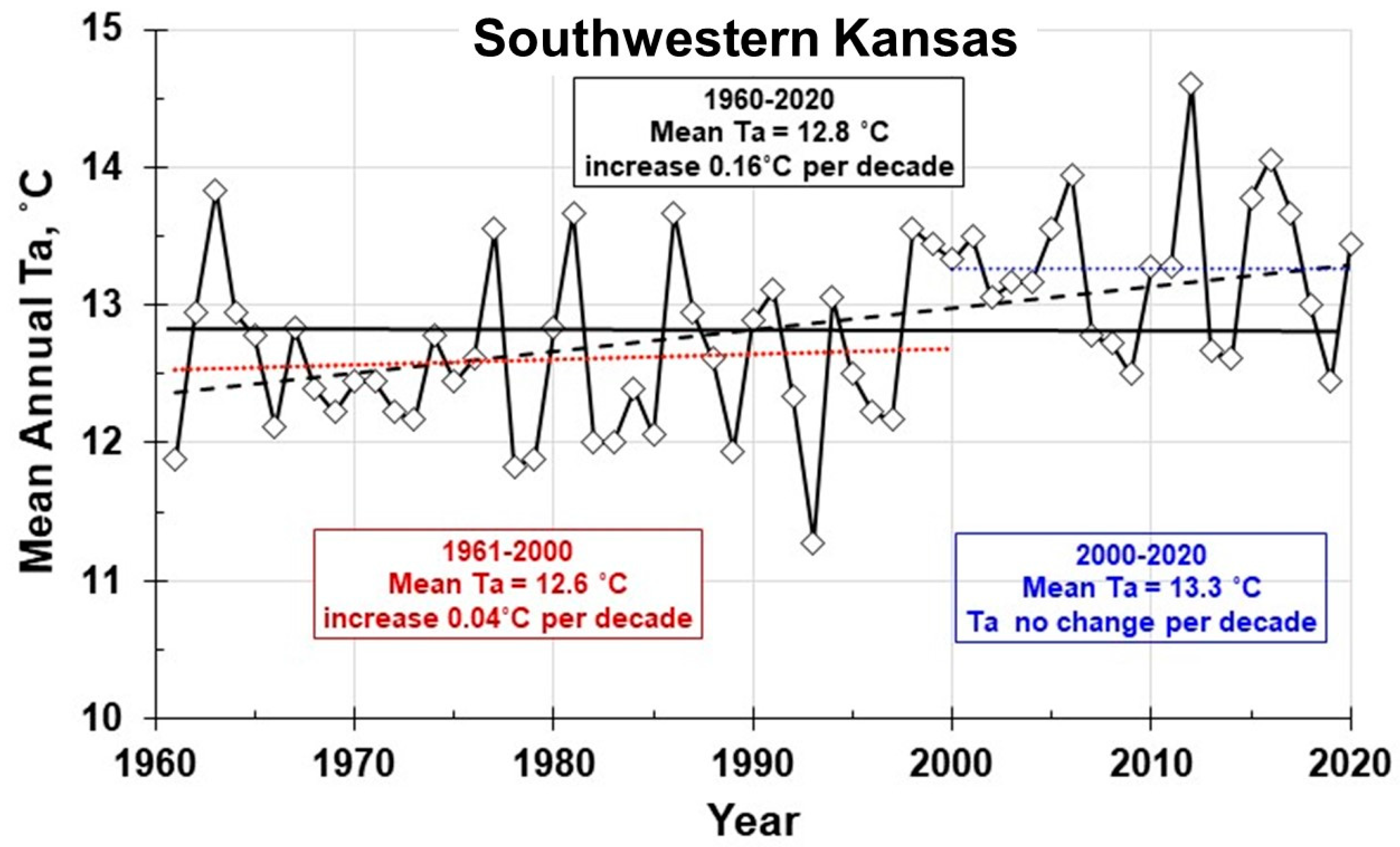
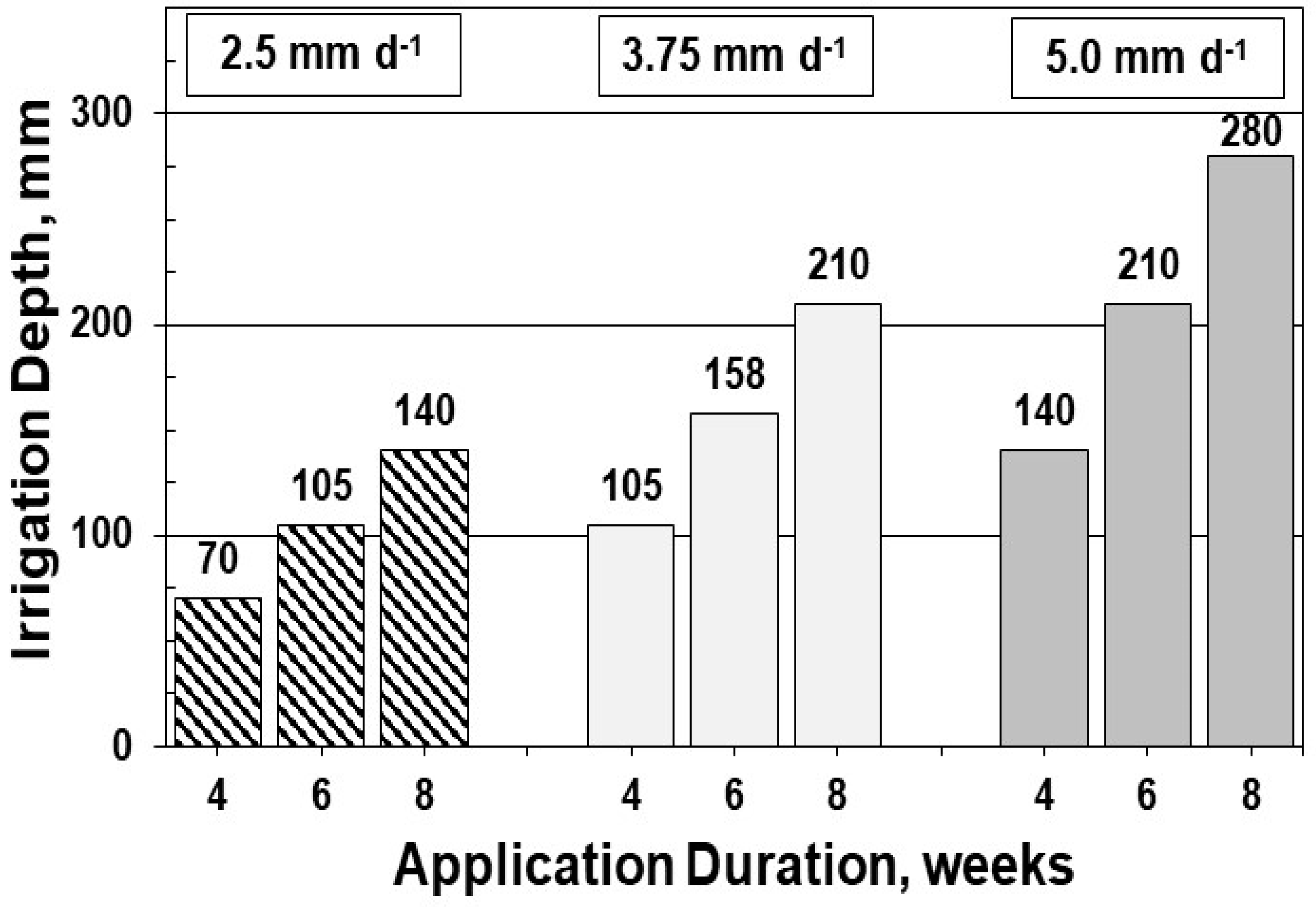

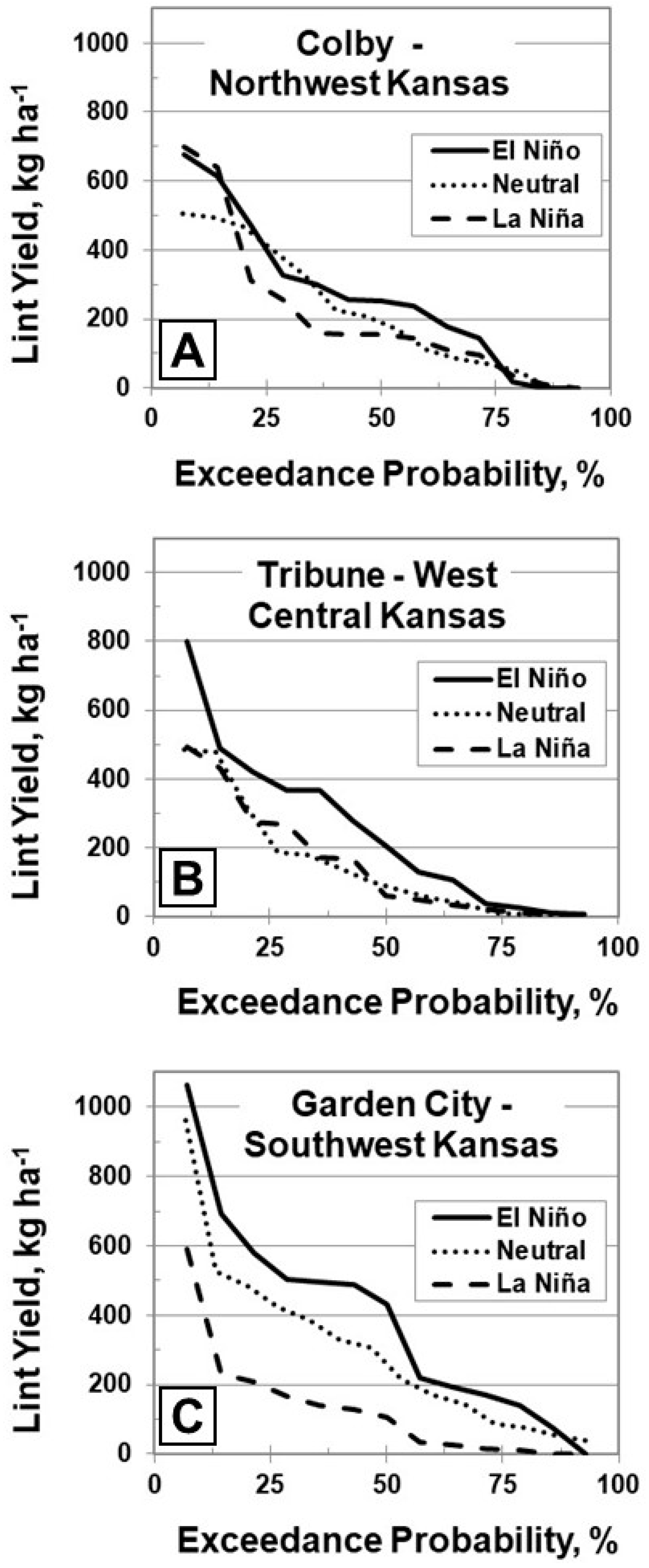
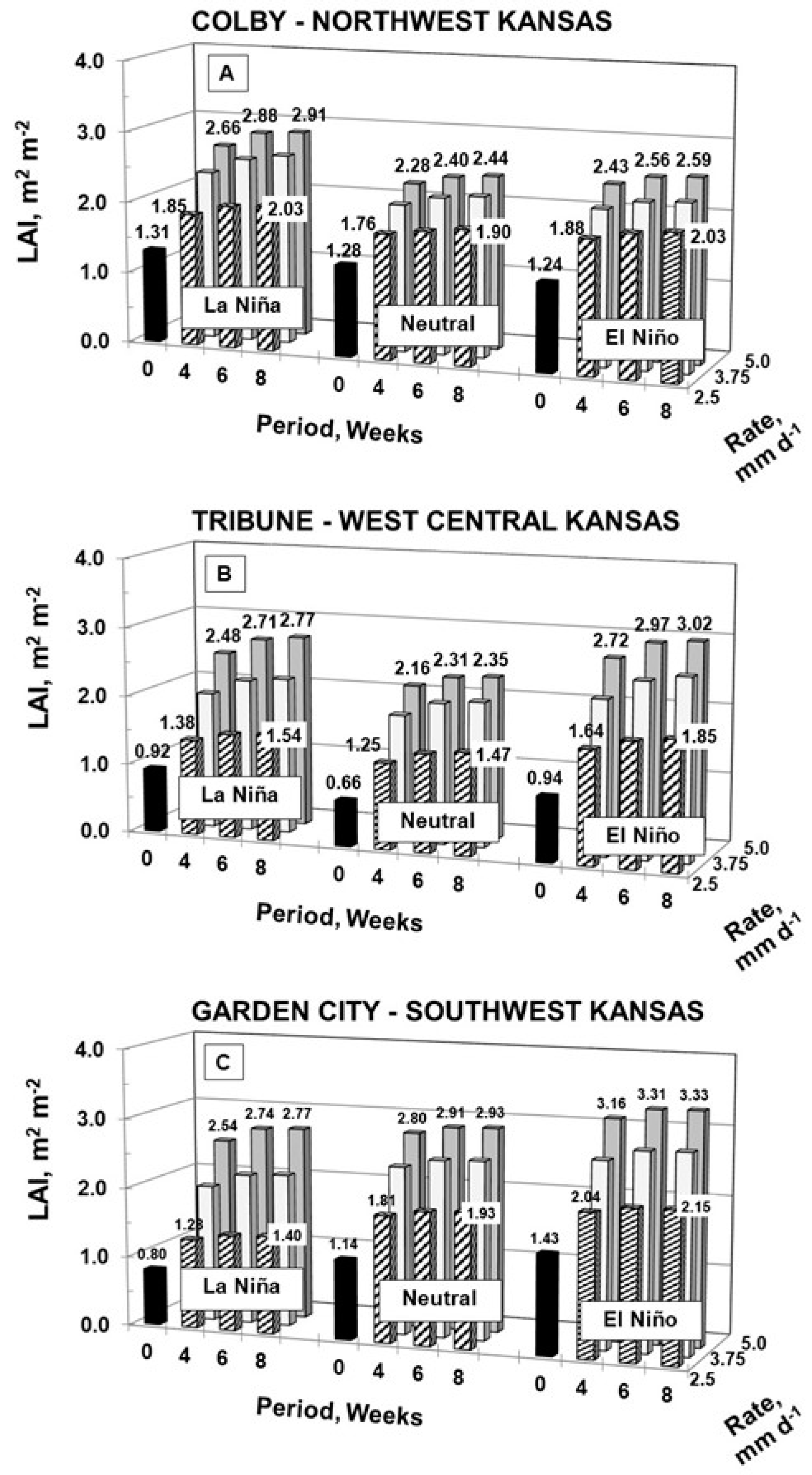
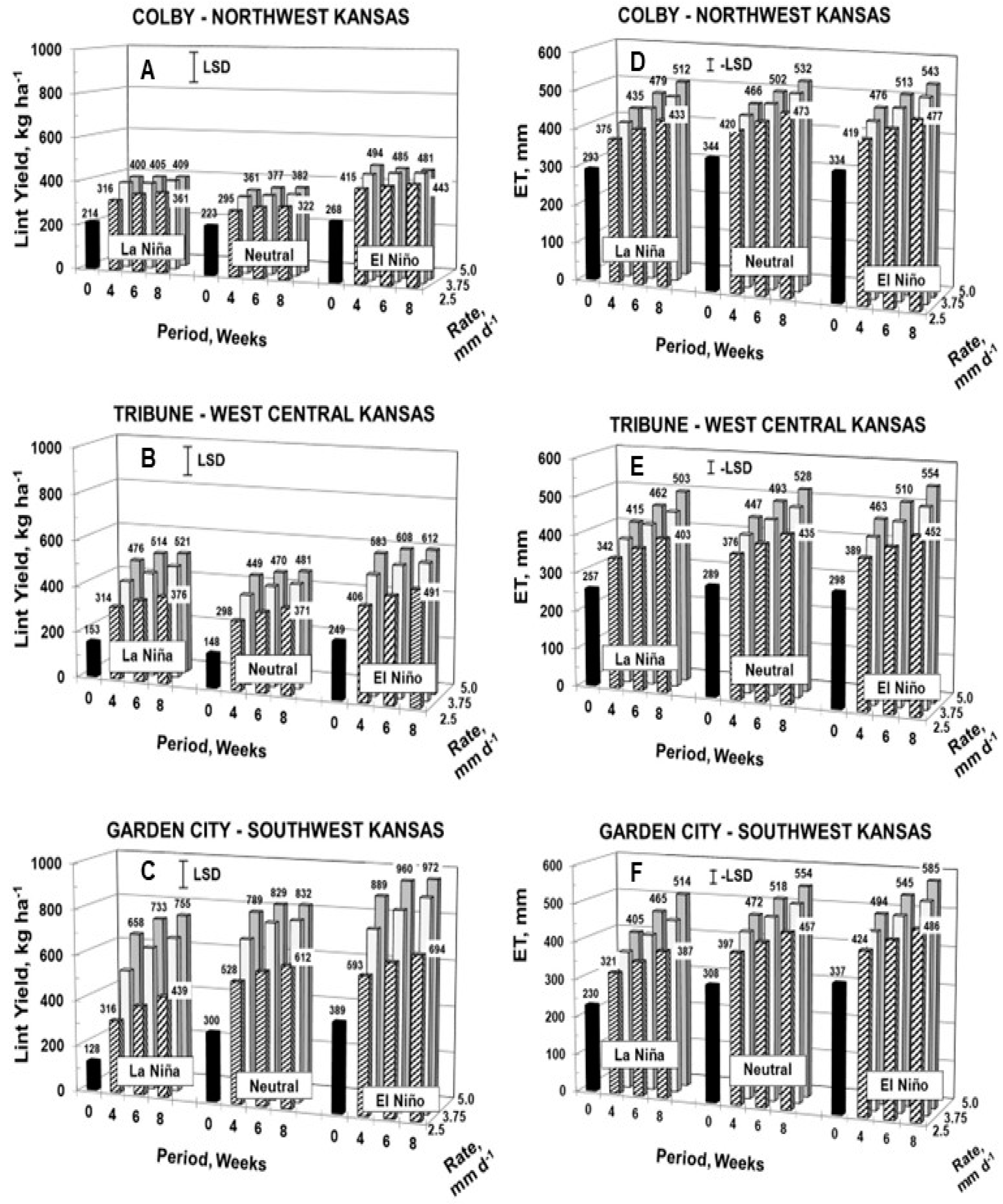
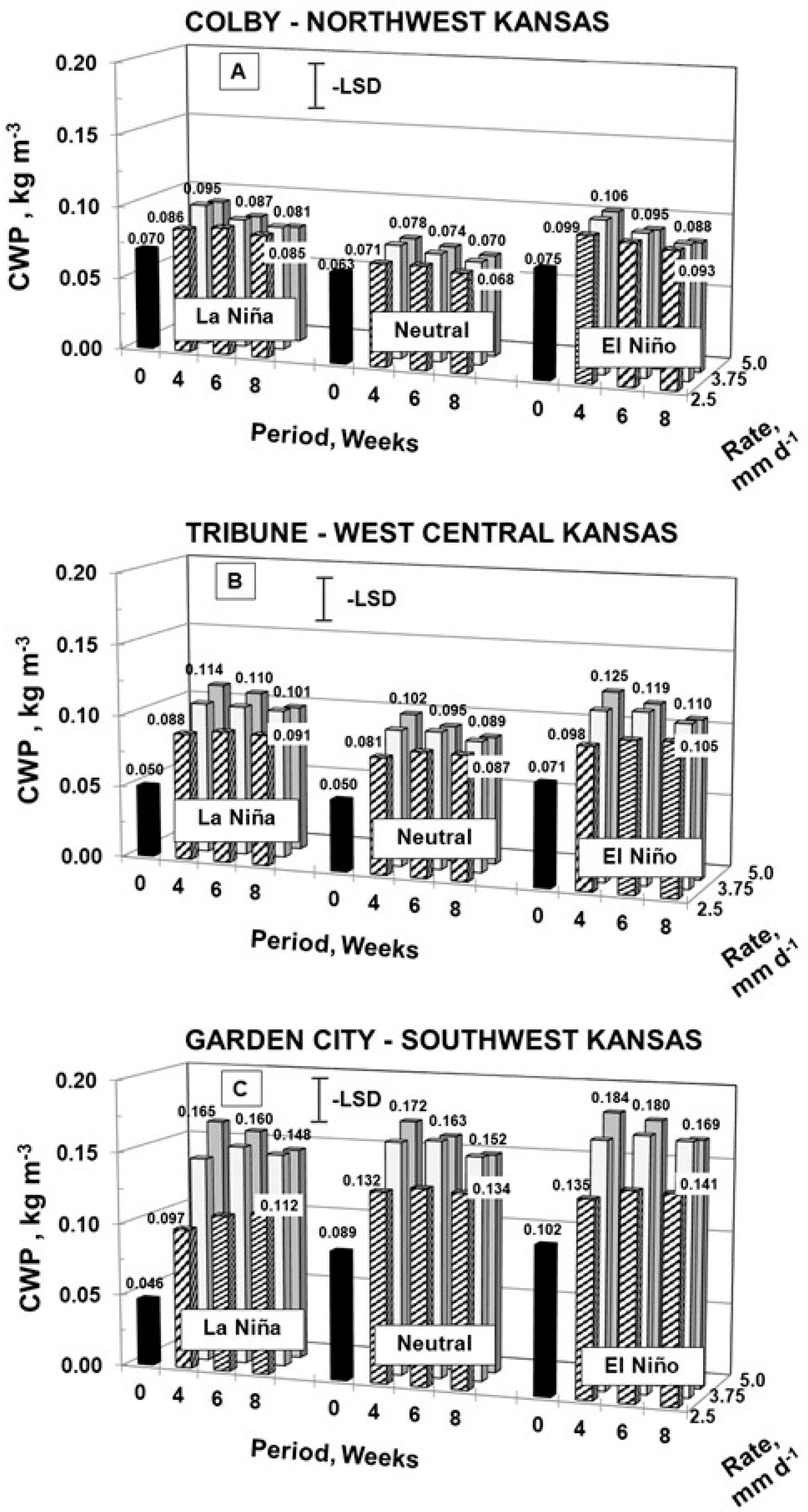
| LAI at 1st Open Boll | Boll Number at 1st Open Boll | Fraction of Bolls Opened | ||||||||
|---|---|---|---|---|---|---|---|---|---|---|
| EFFECT † | Colby | Tribune | Garden City | Colby | Tribune | Garden City | Colby | Tribune | Garden City | |
| ENSO Phase | m2 m−2 | bolls m−2 | % | |||||||
| El Niño | 2.26 a † | 2.38 a | 2.72 a | 37.5 a | 42.4 a | 48.6 a | 47.2 a | 53.8 a | 74.5 a | |
| Neutral | 2.13 a | 1.88 a | 2.42 ab | 35.7 a | 37.0 a | 46.0 a | 33.4 a | 41.6 a | 64.4 a | |
| La Niña | 2.44 a | 2.09 a | 2.04 b | 42.4 a | 40.6 a | 41.9 a | 33.4 a | 44.4 a | 65.3 a | |
| Irrigation Capacity, mm d−1 | ||||||||||
| 2.5 | 1.92 c | 1.54 c | 1.78 c | 35.5 b | 33.9 c | 36.7 c | 41.0 a | 53.0 a | 74.4 a | |
| 3.75 | 2.33 b | 2.19 b | 2.46 b | 39.7 a | 41.4 b | 47.9 b | 36.9 b | 44.7 b | 65.9 b | |
| 5.0 | 2.57 a | 2.61 a | 2.94 a | 40.5 a | 44.8 a | 52.0 a | 36.1 b | 42.1 b | 63.9 b | |
| Irrigation Period, weeks | ||||||||||
| 4 | 2.16 b | 1.96 b | 2.29 b | 38.2 a | 38.5 b | 43.9 b | 39.0 a | 49.0 a | 70.4 a | |
| 6 | 2.30 a | 2.16 a | 2.43 a | 38.7 a | 40.5 a | 46.2 a | 37.6 b | 46.1 b | 67.5 b | |
| 8 | 2.35 a | 2.22 a | 2.45 a | 38.7 a | 41.1 a | 46.4 a | 37.5 b | 44.8 b | 66.4 b | |
| ENSO Phase × Irrigation Capacity | ||||||||||
| El Niño | ×2.5 | 1.97 cd | 1.76 de | 2.11 cde | 34.7 ab | 36.0 bc | 39.8bcd | 51.3 a | 61.8 a | 80.8 a |
| El Niño | ×3.75 | 2.28 bcd | 2.46 bc | 2.77 ab | 37.8 ab | 44.1 abc | 51.1 abc | 46.8 ab | 51.1 ab | 71.5 bc |
| El Niño | ×5.0 | 2.53 ab | 2.91 a | 3.27 a | 39.8 ab | 47.3 a | 54.9 a | 43.6 abc | 48.6 ab | 71.1 bc |
| Neutral | ×2.5 | 1.83 d | 1.38 e | 1.88 ef | 32.3 b | 31.8 c | 38.0 cd | 35.8 bc | 47.4 b | 69.9 bc |
| Neutral | ×3.75 | 2.17 bcd | 1.98 cd | 2.50 bcd | 36.7 ab | 38.3 abc | 48.3 abc | 32.7 c | 39.8 b | 62.7 cd |
| Neutral | ×5.0 | 2.37 abc | 2.28 bc | 2.88 a | 38.1 ab | 40.8 abc | 51.9 ab | 31.7 c | 37.6 b | 60.6 cd |
| La Niña | ×2.5 | 1.96 cd | 1.47 e | 1.35 f | 39.3 ab | 34.0 c | 32.2 d | 35.9 bc | 49.9 ab | 72.5 ab |
| La Niña | ×3.75 | 2.53 ab | 2.14 cd | 2.10 de | 44.6 a | 41.7 abc | 44.4 abc | 31.2 c | 43.4 b | 63.6 bcd |
| La Niña | ×5.0 | 2.82 a | 2.65 ab | 2.68 abc | 43.4 a | 46.2 ab | 49.2 abc | 33.0 c | 40.1 b | 60.0 cd |
| EFFECT | P > F | P > F | P > F | |||||||
| ENSO Phase (P) | 0.49 | 0.13 | 0.05 | 0.13 | 0.39 | 0.35 | 0.21 | 0.39 | 0.22 | |
| Irrigation Capacity (C) | <0.01 | <0.01 | <0.01 | <0.01 | <0.01 | <0.01 | <0.01 | <0.01 | <0.01 | |
| P × C | <0.01 | <0.01 | 0.01 | 0.14 | 0.40 | 0.73 | 0.01 | 0.40 | 0.53 | |
| Irrigation Period (D) | <0.01 | <0.01 | <0.01 | 0.52 | 0.01 | 0.01 | 0.05 | <0.01 | <0.01 | |
| D × P | 0.73 | 0.91 | 0.96 | 0.98 | 0.74 | 0.96 | 0.72 | 0.90 | 0.96 | |
| D × C | 0.95 | 0.67 | 0.91 | 0.43 | 0.89 | 0.16 | 0.40 | 0.94 | 0.25 | |
| D × C × P | >0.99 | 0.99 | >0.99 | 0.77 | >0.99 | 0.91 | 0.95 | >0.99 | 0.98 | |
| Lint Yield | Crop Water Use—ET | Crop Water Productivity | ||||||||
|---|---|---|---|---|---|---|---|---|---|---|
| EFFECT † | Colby | Tribune | Garden City | Colby | Tribune | Garden City | Colby | Tribune | Garden City | |
| ENSO Phase | kg ha−1 | mm | kg m−3 | |||||||
| El Niño | 463 a † | 534 a | 811 a | 482 a | 467 a | 500 a | 0.097 a | 0.112 a | 0.163 a | |
| Neutral | 346 a | 409 a | 712 ab | 475 a | 450 a | 474 a | 0.073 a | 0.091 a | 0.152 a | |
| La Niña | 380 a | 432 a | 567 b | 442 a | 418 a | 409 b | 0.088 a | 0.101 a | 0.137 a | |
| Irrigation Capacity, mm d−1 | ||||||||||
| 2.5 | 361 b | 379 c | 534 c | 433 c | 400 c | 412 c | 0.084 b | 0.092 b | 0.126 b | |
| 3.75 | 407 a | 473 b | 732 b | 471 b | 449 b | 464 b | 0.088 a | 0.105 a | 0.160 a | |
| 5.0 | 421 a | 524 a | 824 a | 495 a | 486 a | 506 a | 0.086 ab | 0.107 a | 0.166 a | |
| Irrigation Period, weeks | ||||||||||
| 4 | 386 a | 425 b | 639 c | 433 c | 406 c | 419 c | 0.091 a | 0.103 a | 0.151 a | |
| 6 | 398 a | 465 a | 710 b | 468 b | 446 b | 463 b | 0.086 b | 0.103 a | 0.153 a | |
| 8 | 405 a | 485 a | 741 a | 498 a | 482 a | 500 a | 0.081 c | 0.099 a | 0.148 a | |
| Irrigation Capacity by Period | ||||||||||
| 2.5 | ×4 | 342 d | 339 f | 479 f | 405 f | 369 g | 380 h | 0.085 bc | 0.089 e | 0.121 d |
| 2.5 | ×6 | 365 cd | 384 e | 542 e | 434 e | 400 f | 413 g | 0.085 bc | 0.094 de | 0.129 d |
| 2.5 | ×8 | 375 bc | 413 de | 582 e | 461 d | 430 e | 443 e | 0.082cd | 0.094 de | 0.129 d |
| 3.75 | ×4 | 399 ab | 435 d | 658 d | 436 e | 408 f | 421 f | 0.094 a | 0.106 bc | 0.158 bc |
| 3.75 | ×6 | 406 a | 481 c | 749 c | 473 c | 451 c | 466 c | 0.087 b | 0.106 bc | 0.163 abc |
| 3.75 | ×8 | 416 a | 504 abc | 790 bc | 505 b | 488 b | 506 b | 0.083 cd | 0.102 bc | 0.158 bc |
| 5.0 | ×4 | 418 a | 502 bc | 779 c | 459 d | 442 d | 457 d | 0.093 a | 0.114 a | 0.174 a |
| 5.0 | ×6 | 422 a | 531 ab | 840 ab | 498 b | 488 b | 509 b | 0.085 bc | 0.108 ab | 0.168 ab |
| 5.0 | ×8 | 424 a | 538 a | 853 a | 529 a | 528 a | 551 a | 0.080 d | 0.100 cd | 0.156 c |
| EFFECT | P > F | P > F | P > F | |||||||
| ENSO Phase (P) | 0.49 | 0.41 | 0.02 | 0.23 | 0.15 | <0.01 | 0.54 | 0.59 | 0.42 | |
| Irrigation Capacity (C) | <0.01 | <0.01 | <0.01 | <0.01 | <0.01 | <0.01 | 0.05 | <0.01 | <0.01 | |
| P × C | 0.99 | 0.84 | 0.23 | 0.09 | 0.92 | <0.01 | 0.81 | 0.65 | 0.06 | |
| Irrigation Period (D) | 0.08 | <0.01 | <0.01 | <0.01 | <0.01 | <0.01 | <0.01 | 0.10 | 0.24 | |
| D × P | 0.96 | >0.99 | 0.74 | 0.64 | 0.82 | 0.09 | 0.60 | >0.99 | 0.84 | |
| D × C | 0.72 | 0.59 | 0.66 | 0.15 | <0.01 | <0.01 | 0.06 | 0.02 | 0.03 | |
| D × C × P | >0.99 | >0.99 | >0.99 | >0.99 | >0.99 | 0.95 | 0.99 | >0.99 | >0.99 | |
| La Niña | El Niño | |||||||||||
|---|---|---|---|---|---|---|---|---|---|---|---|---|
| Irrigation | Full Pivot | Split Pivot Application Depth, mm | Full Pivot | Split Pivot Application Depth, mm | ||||||||
| Capacity, mm d−1 | Depth, mm, at | 4- weeks | 8- weeks | 70 | 140 | 4- weeks | 8- weeks | 70 | 140 | |||
| 4- weeks | 8- weeks | Lint Yield, kg ha−1 | I:D Split | Lint Yield, kg ha−1 (Base Fraction) | Lint Yield, kg ha−1 | I:D Split | Lint Yield, kg ha−1 (Base Fraction) | |||||
| Colby | ||||||||||||
| Dryland | 0 | 0 | 214 | 214 | 268 | 268 | ||||||
| 2.5 | 70 | 140 | 316 b † | 361ab | F | 316 (88%) | 361 (100%) | 415 c | 443 bc | F | 415 (94%) | 443 (100%) |
| 3.75 | 105 | 210 | 386 a | 404 a | 2:1 | 329 (91%) | 341 (94%) | 466 ab | 480 a | 2:1 | 400 (90%) | 409 (92%) |
| 5.0 | 140 | 280 | 400 a | 409 a | 1:1 | 307 (85%) | 311 (86%) | 494 a | 481 a | 1:1 | 381 (86%) | 374 (85%) |
| Across ENSO Phase LSD = 213 kg ha−1 | ||||||||||||
| Tribune | ||||||||||||
| Dryland | 0 | 0 | 153 | 153 | 249 | 249 | ||||||
| 2.5 | 70 | 140 | 314 c | 376 bc | F | 314 (83%) | 376 (100%) | 406 c | 491 b | F | 406 (82%) | 491 (100%) |
| 3.75 | 105 | 210 | 404 b | 485 a | 2:1 | 320 (85%) | 375 (100%) | 514 b | 579 a | 2:1 | 426 (87%) | 469 (95%) |
| 5.0 | 140 | 280 | 476 a | 521a | 1:1 | 314 (84%) | 337 (90%) | 583 a | 612 a | 1:1 | 416 (85%) | 431 (88%) |
| Across ENSO Phase LSD = 195 kg ha−1 | ||||||||||||
| Garden City | ||||||||||||
| Dryland | 0 | 0 | 128 | 128 | 389 | 389 | ||||||
| 2.5 | 70 | 140 | 316 e | 439 d | F | 316 (72%) | 439 (100%) | 593 c | 694 b | F | 593 (85%) | 694 (100%) |
| 3.75 | 105 | 210 | 516 c | 673 b | 2:1 | 387 (88%) | 492 (112%) | 768 b | 912 a | 2:1 | 642 (92%) | 738 (106%) |
| 5.0 | 140 | 280 | 658 b | 755 a | 1:1 | 393 (90%) | 441 (101%) | 889 a | 972 a | 1:1 | 639 (92%) | 680 (98%) |
| Across ENSO Phase LSD = 191 kg ha−1 | ||||||||||||
Disclaimer/Publisher’s Note: The statements, opinions and data contained in all publications are solely those of the individual author(s) and contributor(s) and not of MDPI and/or the editor(s). MDPI and/or the editor(s) disclaim responsibility for any injury to people or property resulting from any ideas, methods, instructions or products referred to in the content. |
© 2024 by the authors. Licensee MDPI, Basel, Switzerland. This article is an open access article distributed under the terms and conditions of the Creative Commons Attribution (CC BY) license (https://creativecommons.org/licenses/by/4.0/).
Share and Cite
Baumhardt, R.L.; Haag, L.A.; Schwartz, R.C.; Marek, G.W. Climate-Informed Management of Irrigated Cotton in Western Kansas to Reduce Groundwater Withdrawals. Agronomy 2024, 14, 1303. https://doi.org/10.3390/agronomy14061303
Baumhardt RL, Haag LA, Schwartz RC, Marek GW. Climate-Informed Management of Irrigated Cotton in Western Kansas to Reduce Groundwater Withdrawals. Agronomy. 2024; 14(6):1303. https://doi.org/10.3390/agronomy14061303
Chicago/Turabian StyleBaumhardt, R. L., L. A. Haag, R. C. Schwartz, and G. W. Marek. 2024. "Climate-Informed Management of Irrigated Cotton in Western Kansas to Reduce Groundwater Withdrawals" Agronomy 14, no. 6: 1303. https://doi.org/10.3390/agronomy14061303
APA StyleBaumhardt, R. L., Haag, L. A., Schwartz, R. C., & Marek, G. W. (2024). Climate-Informed Management of Irrigated Cotton in Western Kansas to Reduce Groundwater Withdrawals. Agronomy, 14(6), 1303. https://doi.org/10.3390/agronomy14061303






